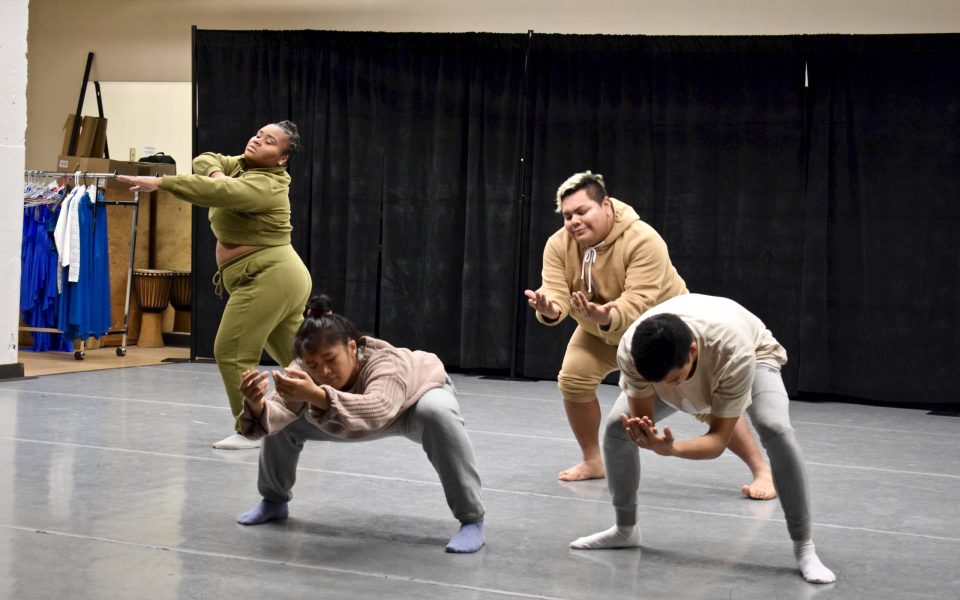Safe from winter’s chill, two or three dozen settle into rows of folding chairs in a small studio on the third floor of the Greensboro Cultural Center, where they will spend time eye-to-eye with four unique dancers.
This evening’s performance creates an opportunity for choreographer-dancers in the North Carolina Dance Project’s Artist in Residence program — Emily Crofford and Jordan Medley of Winston-Salem, Mandi Moore of Greensboro and Perlizbeth “Beth” De Leon of Raleigh — to receive feedback on their works in progress.
“It’s a chance for us to nurture local choreographers and give them free range to experiment since one of the big needs [dancers] were expressing was affordable space,” the project’s co-executive director Anne Morris says. “We thought that’d be a great way to support the creation of new work and communities and exchanges like this. It’s such a nice way to… have frank conversations about what it is to perform and to watch a performer.”
Crofford offered her audience a deeply vulnerable performance, alluding to the ways in which she is processing the ramifications of the #MeToo movement and the sociopolitical climate through dance.
“I’m dealing with… what it means to be a woman and what the female form carries, and what attention you get with a female form whether it’s wanted or unwanted,” she says as she introduces her piece. “I realized there’s this really interesting dynamic within myself where I’ve struggled with body image and… it’s a work in progress… but I’m really happy with my body and what it can do for me and I have curves and I like that!”
Then, in the farthest right corner of the intimate stage setting, Crofford sits on her folded legs, begins to spread her knees outward and arches her back. A shoulder spasm rocks her torso as she gazes backward, and then another, until she flails to the floor. Right hand and leg press against the weight of gravity and she gasps loudly, activating the muscles in that calf and points toes as she rolls onto her stomach and claps her legs together. They hinge upward from knees, cross and she is panting as she flips harshly once more. She is writhing on the floor, gasping intermittently. She is riding an imaginary someone, hands on her hips until she begins to cradle her head, close her eyes and massage her curly tresses. All movement is glacial, pensive, until it’s sudden. She stands and extends her arms out ever wider until she turns away and releases a primal scream.
“I liked that at any moment in the second half a middle finger would’ve been appropriate,” a young man in the audience says afterward. “I felt almost transcendent vibes from you at times and then hiding from yourself almost to then a ‘I-don’t-really-care-to-mess-with-you-right-now’ tone.”
When asked about her creative process, Crofford says, “I didn’t by any means think that this would be the final product. I was just improv-ing … and there were certain movements, like this ‘ticking’ came up and I move from my hips and I started putting it together. I just kept digging, [asking] Why, why? And going further, just past the movement. I journaled a lot during this process and things slowly started to creep up. It came from my initial idea and evolved from there.”
One woman proposes that Crofford experiment with video projection during the performance.
“When you were doing a lot of small gestures that were a little bit difficult to see from this vantage point, I was a curious about projections of just your hands,” she says. “The same thing with sound I wanted to hear more of; there were a lot of interesting sounds you were making from rubbing the floor.”
This isn’t the first time Crofford’s heard this suggestion and she says she’s toying with the idea of adapting the piece into a dance film.
No one struggles to hear the varied, upbeat soundtrack to De Leon and her dance crew’s performance, though. Dressed in sweats, the troupe draws from house, freestyle, waving and vogue styles of dance over multiple acts, featuring group, duet and solo performances. After a few minutes of quiet observations, some attendees engage the dancers, proffering encouragement.
“Let’s gooooooo!”
“Okay, okay!”
“Ayyyyyye!
“Get it!”
An audience member says, “I really like how you engaged that sense of community and brought that sense of hyping and gassing each other up. You brought the audience to you and you brought yourself to us in this performance.”
After a question addressing the dynamic of young people of color performing a routine that featured many street styles within a traditionally formal and white space, a black woman in the audience spoke up.
“With regard to the question of what is it like to be performing in these spaces in this way when your ‘natural’ place is somewhere else: The truth is this space is transformed by you. You are helping us understand and navigate the space you are now controlling and helping us enter into. That is what we do when we bring our bodies in here and we move in this way. That is to say: all of our bodies and all of our ways of being have every right to be here.”
Join the First Amendment Society, a membership that goes directly to funding TCB‘s newsroom.
We believe that reporting can save the world.
The TCB First Amendment Society recognizes the vital role of a free, unfettered press with a bundling of local experiences designed to build community, and unique engagements with our newsroom that will help you understand, and shape, local journalism’s critical role in uplifting the people in our cities.
All revenue goes directly into the newsroom as reporters’ salaries and freelance commissions.


Leave a Reply